From the Ice to Intensive Care and Back

Jack Smiley's Stroke Recovery Journey
April 2024
Cold February air blustered around Endicott College’s on-campus ice rink. Like most afternoons, Jack Smiley was finishing up hockey practice. As a D3 athlete at Endicott, Smiley was used to pushing his body to the limit. But as he finished a usual drill, Smiley suddenly didn’t feel right.
It started with heavy breathing and exhaustion. Disorientation set in, and loss of right sided motor control followed. Within minutes, Smiley lost the ability to speak coherently.
At the age of 22, he was having a stroke. And despite the fast symptom progression, he managed to skate to the sidelines and seek help.
Jack Smiley never fell. Now, in the two years since, he is only rising to greater heights.
The hit that started it all
Smiley has always had the heart of a competitor. Growing up, he was constantly active, and channeled this into a passion for hockey. After playing for two years in the NAHL Junior Hockey League, he joined Endicott’s team as a right wing forward.
Deep into his sophomore season, Smiley collided with another player on the ice.
“It was an innocent hit,” said Smiley. “I’ve sustained a thousand times over my time playing. I had neck tightness, but nothing unusual that would prompt me to see a doctor.”
Two weeks after the hit, Smiley had a ministroke while working out in the gym.
Looking back, he and his clinical team identified that the hit caused a fracture in the C7 vertebra of his neck. This fracture sliced his cervical artery, otherwise known as a cervical artery dissection, which ultimately caused a blood clot.
The physical exertion of working out dislodged his clot. But, by the time he arrived at the hospital, symptoms of right-sided motor loss and disorientation had cleared. With negative imaging results, Smiley returned to normal life under the assumption that he had a severe migraine.
In reality, Smiley had experienced a ministroke.
One week later, a second, bigger clot dislodged from his artery. This time, Smiley was at hockey practice. And unlike his ministroke, Smiley’s symptoms only worsened as minutes went by.
“I was completely out of it. My right side wouldn’t work, and my foot wouldn’t do the things I wanted it to. I made it over to the bench to sit down, and at that point realized I wasn't forming sentences coherently,” explained Smiley.
Smiley was immediately taken to a local hospital. Once his stroke was confirmed, he was transferred to the Neurological Intensive Care Unit (NICU) at Massachusetts General Hospital (MGH).
A relentless pursuit of recovery
The ride into MGH was a whirlwind. Despite the hectic afternoon, Smiley focused on remaining present to the best of his ability.
“I didn’t feel scared,” he said. “I’m someone who takes each situation and moment as they are.”
As clinicians pieced together Smiley’s story, they attributed both strokes to the hit and resulting cervical artery dissection he experienced two weeks prior.
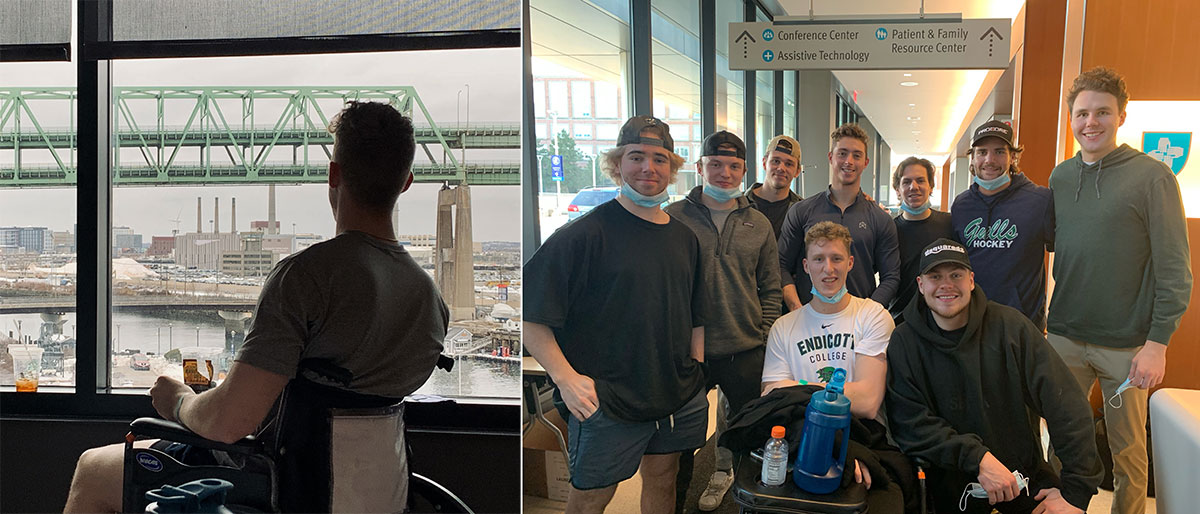
Jack at Spaulding (left), Jack being visited by Endicott hockey teammates (right)
“Everything happens for a reason,” said Smiley. “Truly, MGH was so helpful in my recovery journey. The nurses, staff, everyone was awesome. When given the choice of rehabilitation, the decision was easy. Spaulding was right down the road, and being such a phenomenal facility, I couldn’t pass it up.”
Smiley remained in the NICU for a week before being transferred to Spauling Rehabilitation. He arrived at Spaulding with no function on his right side — unable to eat, speak, or get out of bed.
At Spaulding, Smiley was relentlessly devoted to therapy. His days were filled with six to seven therapy sessions, breaks for meals and family visits, and then nighttime relaxation.
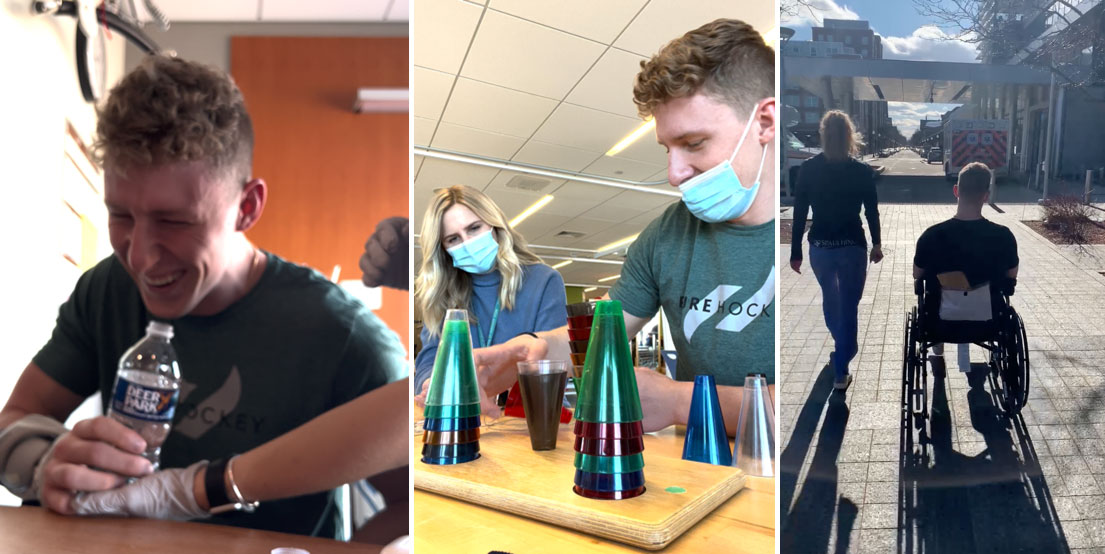 Jack opening a water bottle with the aid of an electric stimulation machine (left), Jack in OT (middle), Jack outdoors at Spaulding (right)
Jack opening a water bottle with the aid of an electric stimulation machine (left), Jack in OT (middle), Jack outdoors at Spaulding (right)
“My team at Spaulding adapted and were incredible. I’d imagine they don’t have many 22-year-olds, and they added in therapy sessions because I wanted them,” stated Smiley. With intensive inpatient therapy, Jack achieved an early goal to get back on the ice just three weeks later with the aid of his therapists. It was a pivotal moment in his rehabilitation.
"There's a special community of caregivers at Spaulding," said Smiley. "Their creative and deeply personal care shows their dedication not just to enable recovery, but to accelerate it.
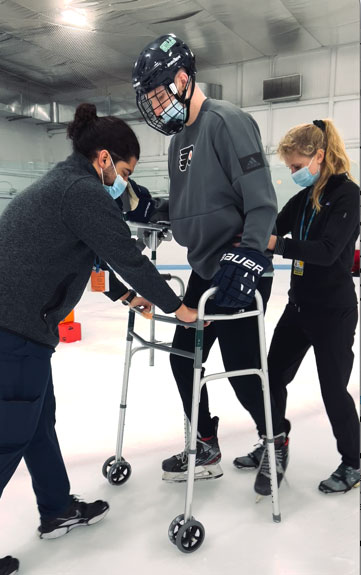
Jack on ice for the first time.
Every day was half a percent better than the day before, and it kept going in that direction. It was tough in the right ways. I saw every challenge as an opportunity to grow and a motivating factor to keep pushing forward.”
In his collegiate era of life, Smiley never expected to go through this journey. However, he lives up to his last name. He didn’t let his positive outlook fall. Instead, he set goals and continuously raised the bar.
“I always knew I would handle it,” said Smiley confidently. “I had a belief in myself that, yeah, this day might be hard, this moment might be hard, but I'll get through it and I'll be stronger for it.”
A proud moment came when Smiley walked out of Spaulding on his own on his discharge day. Donor support played an important role in Jack's story, allowing him to live in donor-funded fully accessible housing close to Spaulding as he continued his outpatient therapy before returning to his home state of Pennsylvania. He has since reached new heights by walking without a cane, driving independently, and now returning to Endicott as a full-time student.
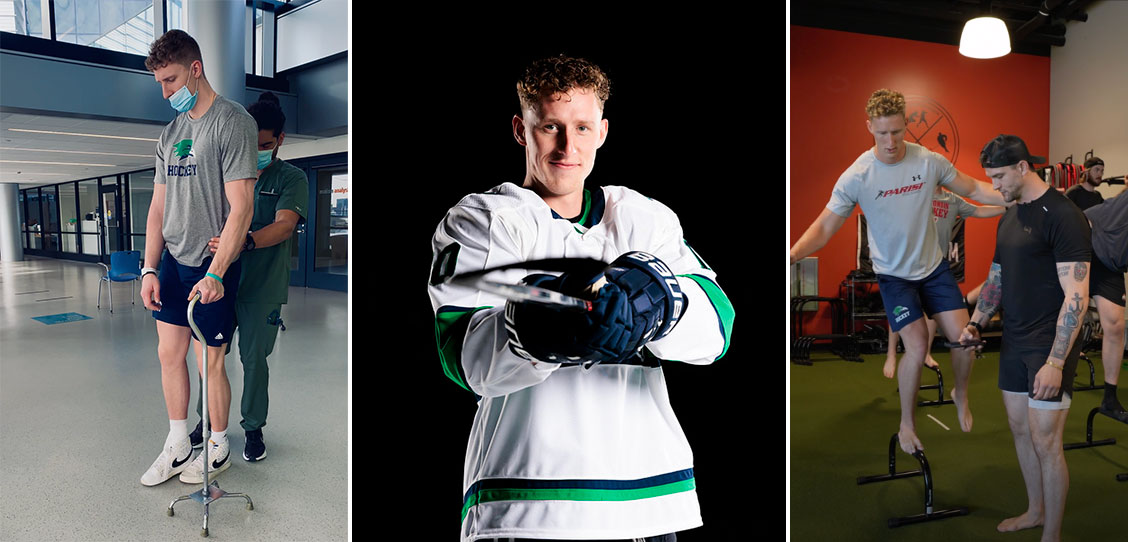
Jack walking with a cane for the first time (left), Jack playing hockey post-stroke (middle), Jack working on strength with friend and trainer Jeff LoVecchio (right)
Finding purpose through social media
Throughout his recovery journey, Smiley also grew his passion for content creation.
Before his stroke, Smiley had started a TikTok account featuring hockey content. A natural creative, he enjoyed the process of editing video clips and developing content.
Post-stroke, this became a vital outlet.
At Spaulding, Smiley was surrounded by his family, friends, and teammates.
“My family was far and away my biggest support through this, and they have been my entire life. This journey has really shown me how much family means to all of us. Their support has made an extremely difficult journey a thousand times easier.”
 Jack and his mom, Debbie Smiley (left), Jack and his brothers, Cole and Drew (middle), Jack with his parents, Peter and Debbie, at Massachusetts General Hospital (right)
Jack and his mom, Debbie Smiley (left), Jack and his brothers, Cole and Drew (middle), Jack with his parents, Peter and Debbie, at Massachusetts General Hospital (right)
But visiting hours ended at 8:00. Without the distraction of therapy or his support systems, he turned to social media.
Whether it was videos about therapy, daily wins, or raw and vulnerable chats, Smiley documented it all.
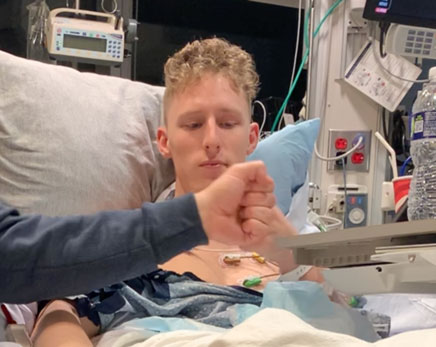
Jack talking with his father in the MGH ICU.
Quickly, his presence began to rise on TikTok and Instagram. Today, Smiley has thousands of followers and videos with millions of views.
“My mission has never been followers or likes,” Smiley expressed. “I just loved diving into it fully, letting my mind go for a bit, and then realized that it was helping people. I try to show how life isn’t perfect, and that’s okay.”
Through his social media presence, Smiley has reached heights beyond his imagination.
 Jack co-hosting the 2024 Endicott Tedx event (left), Jack meeting John Tortorella (middle), Jack speaking at the Penn state Sports Business Conference (right)
Jack co-hosting the 2024 Endicott Tedx event (left), Jack meeting John Tortorella (middle), Jack speaking at the Penn state Sports Business Conference (right)
Since his stroke, Smiley has been featured on numerous podcasts, co-hosted the 2024 Endicott Tedx event, been a panelist at the Penn State Sports Business Conference, and built relationships with prominent sports individuals, such as Flyers’ head coach John Tortorella.
“A main goal of mine now at this stage is just to help as many people as I can,” he said. “I just share what got me through some of my hardships and adversity with the hopes of helping others.”
A trajectory on the rise
Smiley continues to rise above each goal. After returning to Endicott as a full-time student studying exercise science, he’s also back with his beloved Gulls’ hockey team as its captain. #10 is back on the ice, practicing with his team.
Beyond that, he is excited and grateful for the opportunity each day brings to get better.
“You truly never know, when going through something like this, what’s going to happen because of it,” said Smiley. “It could be the worst thing in your life, but it could also be leading you to the greatest things in your life.”
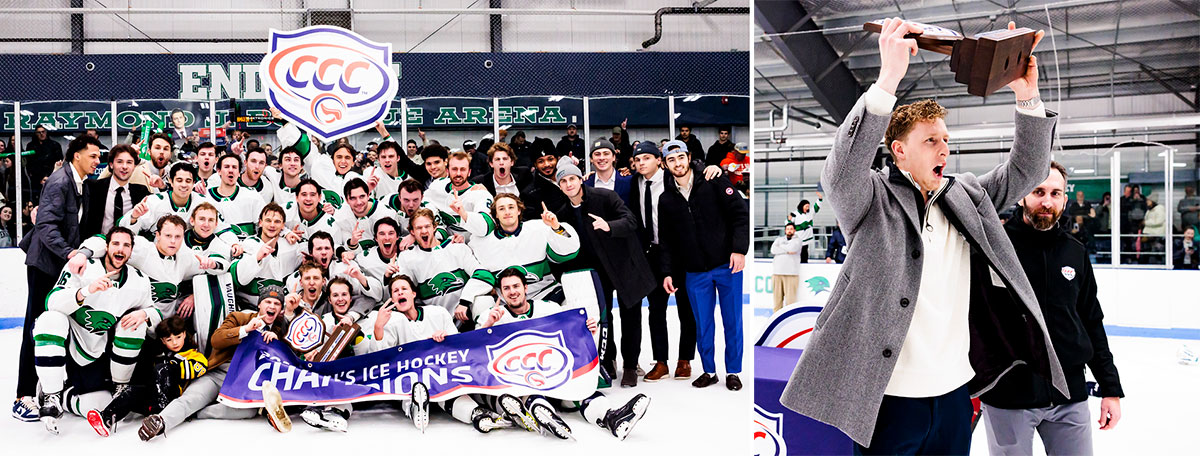 Jack and the Endicott Hockey team after their winning the 2024 Commonwealth Coastal Conference championship
Jack and the Endicott Hockey team after their winning the 2024 Commonwealth Coastal Conference championship
Follow Jack Smiley on Instagram and TikTok @jacksmil1ey
In patients under the age of 50, cervical artery dissections are one of the most common causes of stroke. Learn how to recognize signs of a stroke >
Imagine the Possibilities
At a time when scientific advancements can help make the impossible possible, an investment in rehabilitation medicine has never been more necessary — or more promising.
Your gift to Spaulding can make a real difference... starting now.
